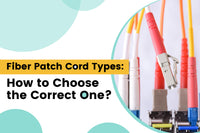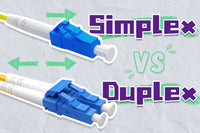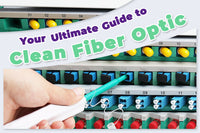Contents
It is known that fiber optic cables are terminated with fiber optic connectors, but how to connect these fiber connectors together? A common and effective solution is the fiber optic adapter. Though fiber optic adapters are small accessories often ignored by technicians, they play a vital role in fiber telecommunications, connecting fiber optic cables and connectors. This article discusses their purposes, features, types, and how to choose and clean them.
What is a Fiber Optic Adapter?
The fiber optic adapter, also known as the fiber optic coupler, is a passive component that enables a detachable connection between two fiber optic cables in the fiber network. It is designed to precisely align fiber connectors coupled on the two sides of the adapter, achieving optical signal continuity. Fiber optic adapters are available in various types to accommodate different kinds of fiber connectors. They are widely used in optical distribution frames, fiber optic telecommunications, LAN and testing devices.
A typical fiber optic adapter is generally composed of the adapter body, alignment sleeve, and dust caps. The alignment sleeve within the fiber optic adapter works to accurately align the fiber cores in fiber connectors, which can help maintain signal integrity. The alignment sleeve can be made of ceramic or metal depending on different needs and manufacturers. The adapter body holds the internal structure, which is made of metallic, semi-metallic or non-metallic materials. They usually come with dust caps or shutters to prevent dust and other impurities from entering and damaging the coupling parts.

Fiber Optic Adapter Types
Due to various applications and fiber optic connector types, fiber optic adapters come in many types. We’ll delve into the types of fiber adapters in the following content.
Based on Connector Type at Both Ends
Standard fiber optic adapters fit the same connector at both ends, such as SC-SC adapter, LC-LC adapter, FC-FC adapter, ST-ST adapter, MPO-MPO adapter, E2000-E2000 adapter, etc. Their design, material, shape and size depend on the type of fiber connector they are attached to. Fiber optic adapters also provide compatibility for different polish types of fiber optic connectors, including APC (Angled Physical Contact), UPC (Ultra Physical Contact), and PC (Physical Contact).
Some fiber adapters are designed to mate different types of connectors. They have different designs on two sides and can be used to connect different fiber patch cords. These hybrid fiber optic adapters include LC to SC adapters, LC to ST adapters, SC to FC adapters, SC to ST adapters, and more types.
The bare fiber adapter is a special type of fiber optic adapter. It can be inserted into any kind of fiber connector, which can make temporary, easy, and quick connections between bare fiber and fiber optic equipment. Bare fiber adapters are widely used for urgent connections and fiber testing.
Note: You can learn about types of fiber optic connectors in our ultimate guide to fiber optic connectors.
Other Classification Aspects
In addition to the connector type, fiber optic adapters also differ in fiber mode and port number, which can also be used to distinguish between different types of fiber adapters.
- Based on Fiber Mode
Fiber optic adapters are designed to connect either single-mode fiber or multimode fiber. The internal structure sizes and materials of single-mode and multimode fiber optic adapters are slightly different. Single-mode fiber optic adapters feature higher alignment accuracy. So you can use a single-mode fiber adapter to connect multimode fibers, but conversely, a multimode fiber adapter is not suitable for connecting single-mode fibers.
- Simplex or Duplex
Fiber optic adapters are available in versions suitable for both simplex and duplex fiber cables. A simplex fiber optic adapter accommodates one connector on each side. A duplex adapter can accommodate two connectors on each side, allowing one duplex fiber cable to be paired with another. This is very useful in systems that use a pair of fiber cables for signal input and output. Quad fiber adapter, designed for compact connectors like LC connectors, can accommodate four connectors on each side. Duplex and higher-capacity fiber optic adapters help enhance installation density and optimize space utilization.
How to Choose Fiber Optic Adapters?
Though many fiber optic adapters look very similar, they differ in quality and performance. The fiber adapter in the link can affect fiber optic transmission. So how to select the right one? Here are some factors that you should consider.
- Connection Requirements
You should identify the type of fiber optic cables and connectors you will need to choose the corresponding fiber adapter. If you need to connect two same fiber patch cables, just choose SC, LC, ST, or FC fiber adapters. For connecting two fiber patch cables with different connectors, you need to select hybrid fiber optic adapters.
- Insertion loss
Attenuation can occur if you insert the fiber connector into the fiber adapter. So, you need to consider the insertion loss of a fiber adapter. Purchasing the fiber optic adapter from a reliable manufacturer can help ensure quality. In general, the fiber adapter is required that the insertion loss be less than 0.2 dB. Additionally, you should also consider the properties of fiber optic cables and connectors.
- Sleeve Material
The alignment sleeve is an essential component for accurate alignment. It can be made of metal or ceramic materials. Compared with metal alignment sleeves, alignment sleeves made of ceramic materials are more robust and less prone to deformations as ceramic features a stable crystal structure. Ceramic alignment sleeves can maintain high mechanical precision over time.
- Durability
Select those fiber optic adapters that can withstand frequent insertion and removal. Quality fiber adapters should withstand up to 1000 plugging and unplugging times without degrading performance.
How to Clean Fiber Optic Adapter?
Many fiber optic components, including fiber optic adapters, require careful cleaning to prevent the contamination of connector end faces and fiber cores and ensure optimal performance. Cleaning fiber optic adapters is not complicated and can be handled using appropriate cleaning tools and solutions.
- Fiber Optic Cleaning Swab: Insert a lint-free swab into the fiber optic adapter, gently twist it, and pull it out.
- Fiber Optic Cleaning Pen: This is a dedicated cleaning device that can be easily pushed into the inside of the fiber adapter, helping you achieve one-click cleaning.
- Ultrasonic Cleaner: This cleaning instrument uses cleaning solutions and high ultrasonic frequencies to remove all contaminants from the fiber optic adapter, offering efficient and complete cleaning.
Summary
Fiber optic adapters are compatible with different connectors, making it easy to connect different fiber patch cables. By understanding their characteristics, types, and cleaning solutions, you can effectively use them to meet the different needs of fiber networks.
For more information on this topic, you can keep up on our blogs. While VCELINK offers general and basic information for our customers and other visitors to the website, it’s not professional advice.



Be the first one to comment.
Leave a comment